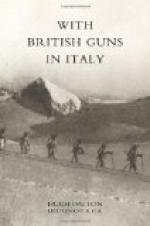* * * * *
I woke several times in the night and early morning, and, half asleep, looked out through the carriage window upon wonderful sights. A railway platform like a terrace in a typical Italian garden, ornate with a row of carved stone vases of perfect form, and vines in festoons from vase to vase, and dark trees behind, and then a downward slope and little white houses asleep in the distance. This I think was close to Brescia. Then Desenzano, and what I took to be the distant glimmer of Lake Garda under the stars. Verona I passed in my sleep, having now crossed the boundary of Lombardy into Venetia, and Vicenza and Padua are nothing from the train. At Mestre, the junction for the Front, all the Italian officers got out, and I went on to Venice.
Except for three British Naval officers I was, I think, the only foreigner there, and a priest, whom I met, took me for an American. Everything of value in Venice, that could be, was sandbagged now for fear of bombs, and much that was movable had been taken away. I spent three hours in a gondola on the Grand Canal and up and down the Rii, filled with a dreamy amazement at the superb harmonies of form and colour of things both far away and close at hand. And even as seen in war-time, with all the accustomed life of Venice broken and spoiled, the spaciousness of the Piazza S. Marco, and the beauty of the buildings that stand around it, and at night the summer lightnings, and a rainstorm, and a cafe under the colonnade, where music was being played, will linger always in my memory. All the big hotels were closed now, or taken over by the Government as offices or hospitals, and the gondolas lay moored in solitary lines along the Grand Canal, and even the motor boats were few and, as a waiter said to me, “no one has been here for three years, but the people are very quiet and no one complains.”
CHAPTER III
FROM VENICE TO THE ISONZO FRONT
I left Venice next morning by the 5.55 train, and reached Palmanova at half-past ten. As one goes eastward by this railway, there is a grand panorama of hills, circling the whole horizon; to the north and north-east the Carnic Alps and Cadore, their highest summits crowned with snow even in the full heat of summer; eastward the Julian Alps, beyond the Isonzo, stretching from a point north of Tolmino, down behind the Carso, almost to Fiume in the south-east; and yet further round the circle to the southward the mountains of Istria, running behind Trieste and its wide blue gulf, whose waters are invisible from this railway across the plain.




